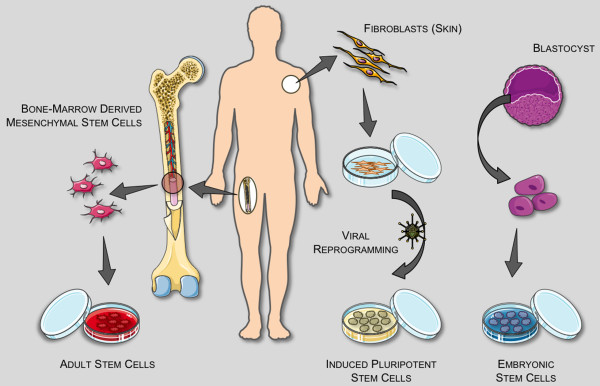Figure 1.
Stem cell sources and definitions. A stem cell is a cell capable of proliferating for long periods and differentiating into specialized cells that make up the tissues and organs of the body. A single pluripotent stem cell can give rise to cells that develop all three germ layers (mesoderm, endoderm, ectoderm) that constitute the body. There are three general classifications of stem cells: adult stem cells (ASCs), embryonic stem cells (ESCs), and induced pluripotent stem cells (iPSCs). An ASC is an undifferentiated (unspecialized) cell that occurs in a differentiated (specialized) tissue, renews itself, and becomes specialized to yield all of the cell types of the tissue from which it originated. ASCs usually divide to generate progenitor or precursor cells, which then differentiate or develop into 'mature' cell types that have characteristic shapes and specialized functions. They have a more limited differentiation profile (termed 'multipotent') than pluripotent ESCs/iPSCs, but are non-tumorigenic, and can be isolated and/or mobilized from many tissue sources, likely making them the most readily adapted cell source for regenerative medicine. The most well researched ASCs are mesenchymal and hematopoietic stem cells, originally isolated from bone marrow. An ESC is derived from a group of cells called the inner cell mass, which is part of the early (4- to 5-day) embryo called the blastocyst. Once removed from the blastocyst, the cells of the inner cell mass can be cultured into ESCs. ESCs have nearly unlimited proliferation and differentiation potential, but there are intrinsic tumor and ethical concerns, and differentiation pathways are poorly understood/controlled currently. An iPSC is a stem cell that has been created from an adult cell - such as skin or blood - through the introduction of genes that reprogram it into a cell with the characteristics of an ESC. iPSCs have the advantage of not having to be derived from human embryos, a major ethical consideration. Another critical advantage of iPSC technology is that, in theory, it allows for the creation of cell lines that are genetically customized to a patient, bypassing issues of immune rejection. Retroviral induction is currently required to reprogram adult cells, which is problematic. It also remains to be seen whether reprogrammed skin cells differ in significant ways from ESCs, but in early studies they appear to exhibit the same key features: the ability to differentiate to any of the 220 types of cells in the human body, and the ability to reproduce indefinitely in culture. Readers interested in more general information about stem cells are referred to the NIH Stem Cell Information web site [109]. Servier Medical Art (Servier, Suresnes, France) was used in assembling Figure 1.

